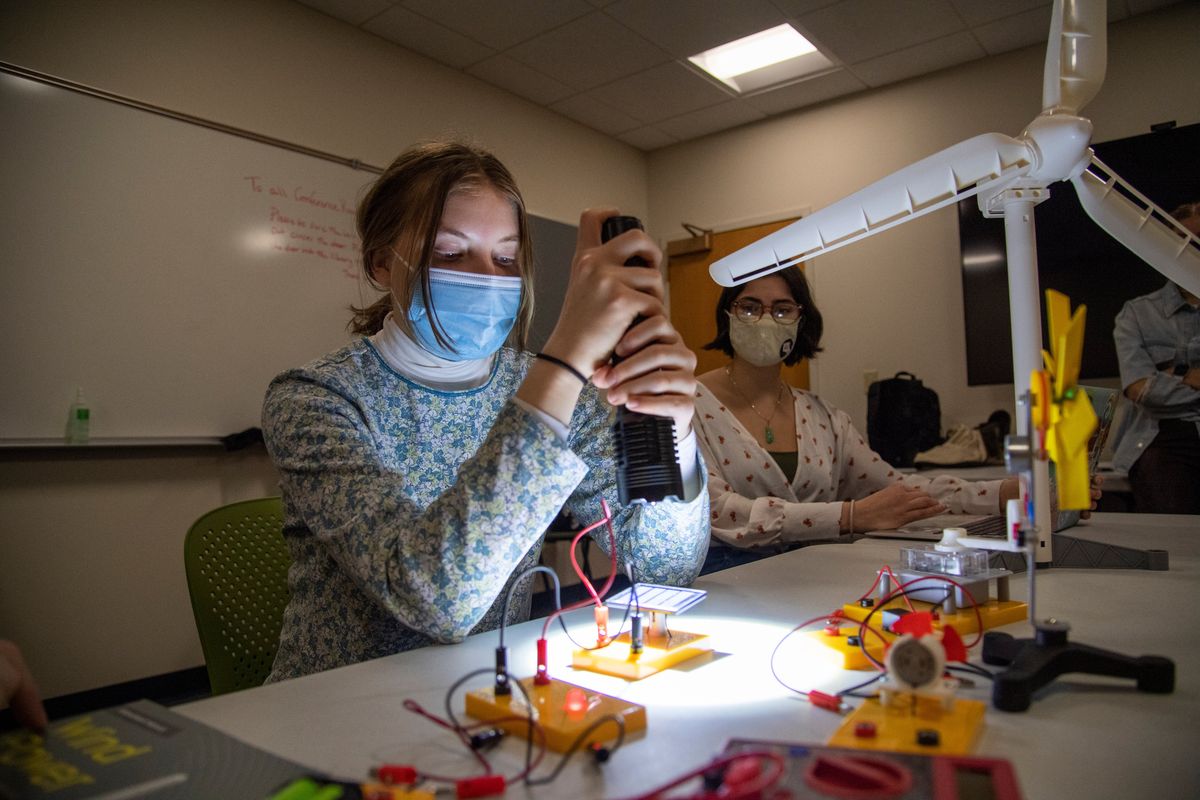Climate in the classroom: Gonzaga students primed to take lessons to Spokane elementary schools

Environmental studies majors Jordan Cruz and Nina Berry are well aware that studying climate science involves complicated concepts and terminology.
Knowing that, the two are among a group of Gonzaga University students tasked with teaching, and perhaps enhancing, climate science education to children who might not yet even be able to spell “concept” or “terminology.”
Cruz and Berry are part of Gonzaga’s Climate Literacy Fellows program, an initiative funded by donations and a $100,000 ClimeTime grant from the Washington state Office of the Superintendent of Public Instruction. Through a partnership with Spokane Public Schools, the Climate Fellows plan to visit second- through fifth-grade classrooms in the coming months to give lessons on climate change and renewable energy.
Specifically, the Gonzaga students are focused on schools within neighborhoods highlighted by the university’s Opportunity Northeast initiative – namely Title 1 schools such as Bemiss, Lidgerwood and Longfellow elementary schools, said Brian Henning, director of Gonzaga’s Center for Climate, Society and the Environment.
Incorporating kits with interactive devices like solar-powered fans, buzzers and battery chargers, the lessons will revolve around concepts including renewable and nonrenewable energy, as well as the differences between weather and climate, said Cruz, a junior. She said the Climate Fellows also plan to give students take-home materials to reflect on and discuss with their parents.
“I think what we’re really trying to do is to not make an enemy out of our lessons,” Cruz said. “We don’t want to make anyone upset or angry because, for some, climate science can be a difficult subject.
“We just want to have it be practical, because a lot of these elementary-schoolers will have to deal with climate change probably more than any other generation now.”
Berry said when students teach students, it offers learners a different perspective with “a new face in the classroom to inspire different things.”
“It’s been a lot of work, so I haven’t gotten a chance to stand back and look at the whole picture of the impact of it,” she said, “but I just hope this program can continue on.”
The lesson plans designed by the Climate Fellows aren’t just about students teaching students, however, but also about students teaching teachers.
John Traynor, associate professor of teacher education, said the goal by April is to make a recommendation to the district on whether to purchase the kits so teachers can apply the lessons themselves.
“Regardless of what activities you’re doing, interactions with college students and elementary school students has a really powerful opportunity to help students see a path in the future where they could also achieve that as well,” he said. “It makes it a little less mysterious and a little more real for them.”
Kelly Kielian, elementary school science coordinator for Spokane Public Schools, said lessons about weather typically start in kindergarten and scale up from there. Second-graders dive into water erosion and human impacts on surroundings, while climate and weather lessons continue into third grade. Fourth grade is when the curriculum really moves into renewable and nonrenewable sources of energy, she said.
“Renewable energy, we are hoping to bring in more with these extension lessons, so that’s why we’re super excited about this partnership and being able to get involved in this project,” she said.
Kielian said the district has used similar engineering activities to deliver more in-depth climate-centric lessons. Such activities include building sun shelters to “protect” animals made from ultraviolet beads, which change color in sunlight.
“I think it’s an opportunity for students and families and our educators to continue to learn these topics, because these are things that the students are going to see throughout their lives,” Kielian said. “Providing them with these learning opportunities and these activities for them to start considering all the ways we impact the climate, the environment and how society comes into that, I just think that’s really important so that they can have a space at the table to be able to engage in those conversations and learn more.”
The Climate Fellows program was launched at the start of the fall semester through Gonzaga’s Center for Climate, Society and the Environment, which was established this past spring.
The Climate Fellows are led by Henning, Traynor and Karli Honebein, the Climate Center’s program coordinator. Traynor and Jaclyn Keller, a master’s in teaching student, helped the Fellows over the fall semester with developing lesson plans and preparing for their in-school appearances.
They also had to fine-tune the kits, as Gonzaga senior and Climate Fellow Emily Wright said some of the models either didn’t fit in with the lesson plans, were too flimsy or required too many consumable parts.
Henning said students worked to design lessons aligned with the state’s K-12 learning standards, as well as the 5E Model of Instruction. A phased approach to teaching, the five E’s stand for engage, explore, explain, elaborate and evaluate.
“It’s easy to sort of do something to be engaging,” Henning said, “but we want to show that it’s in service of a coherent program of study, that it’s supporting the state’s goals and helping students understand certain key scientific concepts.”
The Climate Fellows program is exploring possible grant funding to tailor climate science lessons for the middle school level, Traynor said.
“I know, walking away from this, I’ll be excited if I just meet a few students who are super excited about what we’re doing,” Cruz said. “I think that’s what makes it all worth it, even if it is just a few.
“Knowing that there’s a few students who maybe gets their passion ignited by us going in, I think that that’ll be super special … Hopefully one day, they can come in and do a better job than we have.”